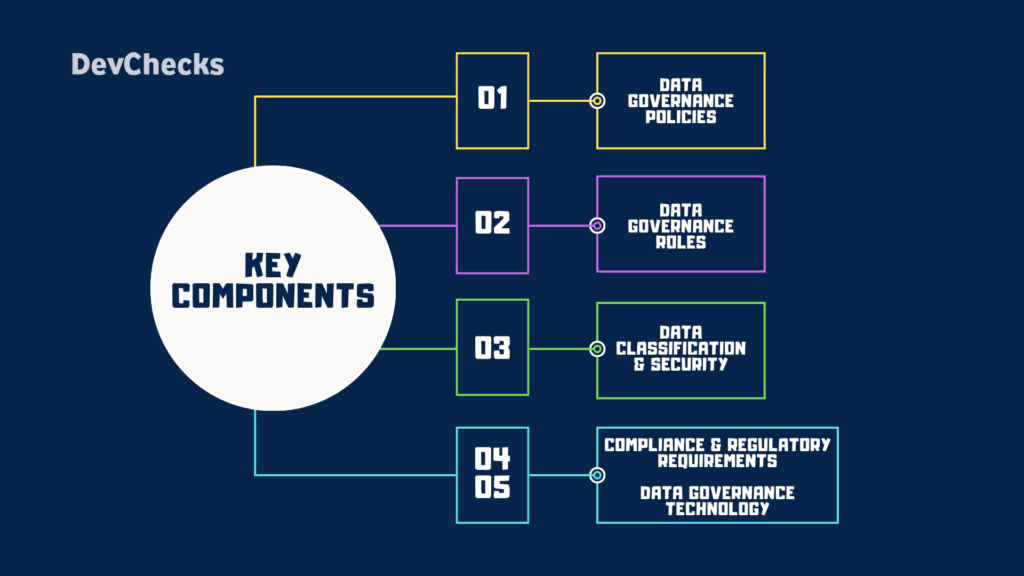Introduction #
In today’s digital world, businesses generate vast amounts of data daily. However, without proper management, data can become a liability rather than an asset. Data governance ensures that data is accurate, secure, and compliant with regulations, allowing organizations to make informed decisions while avoiding costly mistakes.
This guide will break down what data governance is, why it matters, and how businesses can implement a solid governance strategy to maintain data integrity and security.
What is Data Governance? #
Data governance is the framework of policies, processes, and technologies that ensure an organization’s data is:
- Accurate – Free from errors and inconsistencies.
- Consistent – Standardized across different systems.
- Secure – Protected against unauthorized access and breaches.
- Compliant – Aligned with regulatory standards like GDPR, CCPA, and HIPAA.
It involves defining who can access data, how it is used, and how it is protected across an organization.
Why is Data Governance Important? #
- Ensures Data Quality – Eliminates duplicate, outdated, or incorrect data.
- Protects Against Cyber Threats – Reduces the risk of data breaches.
- Helps Achieve Compliance – Meets legal requirements for data protection.
- Improves Decision-Making – Ensures reliable data for analytics and AI.
- Reduces Costs – Prevents inefficiencies caused by poor data management.

Key Components of Data Governance #
1. Data Governance Policies #
Organizations must define clear policies regarding:
- Data ownership – Who is responsible for maintaining data?
- Data access – Who is allowed to view or modify data?
- Data retention – How long should data be stored?
- Data privacy – How is customer data protected?
2. Data Governance Roles #
Successful governance requires a dedicated team to enforce policies:
- Chief Data Officer (CDO) – Oversees governance initiatives.
- Data Owners – Manage specific datasets and ensure compliance.
- Data Stewards – Maintain data quality and security.
- IT & Security Teams – Implement technical protections and access controls.
3. Data Classification & Security #
Not all data is equal. Businesses must classify data based on sensitivity and risk:
- Public Data – Available to anyone (e.g., website content).
- Internal Data – Confidential business information.
- Sensitive Data – Personally identifiable information (PII), financial records, or intellectual property.
Security measures like encryption, access controls, and data masking help prevent unauthorized access.
4. Compliance & Regulatory Requirements #
Data governance helps businesses comply with laws such as:
- GDPR (General Data Protection Regulation) – Governs data privacy in the EU.
- CCPA (California Consumer Privacy Act) – Protects consumer data in California.
- HIPAA (Health Insurance Portability and Accountability Act) – Regulates healthcare data security.
Failure to comply can result in huge fines and reputational damage.
5. Data Governance Technology #
Modern organizations use AI-driven data governance tools to automate tasks such as:
- Data classification and tagging.
- Automated compliance monitoring.
- Real-time threat detection.
Popular tools include Collibra, Talend, and IBM Data Governance.
How to Implement Data Governance in Your Business #
Step 1: Define Governance Goals #
Identify why data governance is needed—is it for security, compliance, or decision-making?
Step 2: Assign Roles & Responsibilities #
Establish a governance team with clear roles (CDO, data stewards, security teams).
Step 3: Create Data Policies #
Develop guidelines on data storage, access, security, and compliance.
Step 4: Invest in Data Governance Tools #
Use AI-powered solutions to automate data classification and policy enforcement.
Step 5: Educate Employees #
Train employees regularly on data handling best practices to prevent costly human errors.
Step 6: Monitor & Improve #
Regularly audit and refine governance strategies to stay compliant with changing regulations.
Conclusion #
Data governance is not just a compliance requirement it’s a business necessity. By ensuring that data is secure, accurate, and well-managed, businesses can improve decision-making, prevent breaches, and build customer trust.
If your business is looking to implement strong data governance solutions, now is the time to start. Need expert guidance? Contact us today to learn more about our data governance services.



